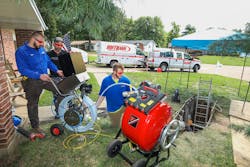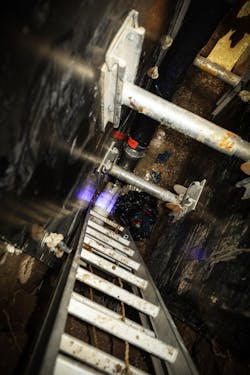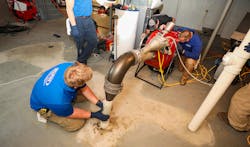As our homes and business properties age, piping and sewer lines take a silent beating below our trees, yards and driveways -- pummeled by roots, weather, and natural wear and tear. As contractors, we of course have a choice in how we approach aging and damaged sewer line repair and replacement. I’m a fan of another R-word the Environmental Protection Agency (EPA) uses for newer versions of this process: Rehabilitation.[1]
Most companies and consumers are beginning to get it: pay more attention to Reuse and Recycling (currently trending R-words) or else. That’s where the most popular methods of trenchless sewer rehabilitation step in. It’s how we’ve been growing new revenue for the plumbing arm of our St Louis company, and it’s been mattering more and more for the R-words we most desire from our customers: Respect, Reviews and Referrals.
The Old Way
The original method was pretty straightforward: dig it all out, lay the new piping, cover it all up, bill the client. Of course, we know it plays out a bit more complicated than this. Here are a few of the unavoidable realities of the old way of repairing sewer lines succumbing to cracks, leaks, root invasion and deterioration:
- Know and remain compliant with OSHA Trenching and Excavation Safety Requirements[2]
- Dig the entire length of the sewer pipeline using heavy, expensive machinery rolled onto location by heavier, more expensive machinery
- Remove invasive trees and root systems
- Tear into driveways, gardens and often into the public right of way section of the line (shared city sidewalks and similar spaces)
- Replace the outdated piping and reconstruct the yard
- Have your team lined up: plumbers, engineers, equipment operators, traffic team for blocked areas and more
Probably the roughest part of this scenario is seeing our clients lose most of a yard they’ve poured themselves into, especially when it might include an item of historical value like a beloved aging tree that adds great personality to the location.
The timeline and costs associated with yard excavation aren’t always kind. Customers are prone to experience angst throughout a yard excavation. Be sure to add some extra customer service training to all team members on these types of complicated jobs.
The New Way
New trenchless sewer repair methods, given to us by the British in the 1970s, provide our team with an opportunity to unveil new and tested technologies now entering the mainstream. There are a lot of advantages to the trenchless method. Camera inspection now instills customer education for a higher level of confidence. Companies are adding environmental awareness and major excavation avoidance to a sales pitch that must be relevant to the ever-evolving customer.
Below are the most popular approaches to trenchless rehabilitation. Each will require a team well-educated on techniques and frequently updated technology.
Camera Inspection
Seeing is believing for most clients. We’re not expecting our customers to have knowledge of sonar location technology to identify underground lines. And we’re certainly not going to have them crawl down and take a look at the crack or deterioration of the pipes. It’s only our word telling the scenario -- and that’s especially delicate when building new-client trust.
But with the introduction of fiber optic camera technology, we can now provide our clients with images and closed-circuit TV video of a thorough and reliable sewer inspection. This creates a real “here’s your chance to review the issue for yourself” relationship that establishes trust and often closes the sale. Offering a sewer camera inspection for all relevant scenarios cannot be skipped in today’s YouTube culture.
Slip Lining
This is the “old version of the new method,” and slip lining is where smaller carrier pipes get inserted into the currently damaged piping. These are fully constructed pipes that get pulled through the cracked pipes to rehabilitate the existing system. Grouting of the entire annular space finishes the job and creates the seal. Sewer and water lines get rerouted from the source and use these new carrier pipes. The damaged pipes simply become obsolete. Maximum installation is typically 300 meters (1,000 ft). Some advantages of slip lining include:
- Major excavation avoided
- Minimum environmental disturbance
- Very cost-effective trenchless technology
- Training and equipment is accessible to nearly all contractors
- Segmental slip lining methods do not require a rerouting of the existing flow
You’ll miss out on some pipe flow capacity, but once up and running, it’s typically a small, forgotten consequence and a bigger win for all parties.
Pipe Bursting
This popular no-dig method is sometimes referred to as in-line expansion. It typically begins with a camera inspection. We then dig contained entry and exit points to gain pipe access. We’ll heat-weld the new sewer line pipe above ground for precision, and finally we mechanically pull the new pipe through existing piping, bursting the old pipe in the process to give way to the newly installed pipe. Maximum installation is typically 230 meters (750 ft).
Like all trenchless technologies, pipe bursting has become valuable in densely populated areas because it limits the impacts of excavation and construction that disrupt homeowners, businesses and traffic. Here are a few reasons to believe:
- Major excavation avoided
- Minimum environmental disturbance
- Largest increase in pipe flow capacity - While some methods decrease the available diameter and capacity inside the pipe, pipe bursting typically increases pipe capacity. This is both an engineering and a customer win.
- Lifespan of piping - This can often range from 50-100 years depending on the conditions of the repair.
Cured In Place Piping (CIPP)
Our team is probably most excited about the current leaps with the Sewer Pipe Lining process, also called Cured-In-Place-Piping (CIPP). Often classified as a no-dig repair (you’ll still need entry and exit points), sewer lining will insert epoxy-saturated pipe tubing into existing pipes, invert and inflate the tubing, and cure it into place with hot air, steam or the new bluelight LED technology. The result: a newly repaired seal that lines the walls of broken piping. Maximum installation is typically 900 meters (3,000 ft). Advantages include:
- Major excavation avoided
- Minimum environmental disturbance
- Largest trenchless install option available
- Offers the newest proven technology to customers
- Bluelight LED curing dramatically reduces waiting times
- Works for horizontal, lateral and vertical pipes
- Typical pipe lifespan of 50+ years
The original method for curing in-place epoxy pipe lining inflates hot air into the tubing, and the curing process would typically take 4-6 hours. Now we have the option of using a resin that specifically reacts to Bluelight LED and has really come to the forefront within the last decade. When Bluelight LED is used, the curing process is about five times faster than the traditional hot air method. Reducing hourly costs will always be a win for the client.
Train Your Teams!
Manufacturers are poised to include training with their tech. Video and in-person trenchless technology equipment training is the norm for inversion drums for CIPP, Bluelight LED curing and the required basic trenching and excavation that does accompany all methods. We know customers are hungry for these “no-dig” options, so if you’re a contractor that’s serious about the future of sewer repair, you owe it to yourself to stay current and roll out trenchless sewer rehabilitation.
Robert Hoffman is the original owner and CEO of Hoffmann Brothers, based in St Louis, Missouri. He received his BS in Mechanical Engineering from University of Missouri Rolla and is a registered Professional Engineer. He served on the Advisory Boards of Ranken Technical College and Vatterott Technical College and the Better Business Bureau’s Executive Board and dispute resolution committee. Hoffmann Brothers was voted 2019 ACCA Residential Contractors of the Year.


